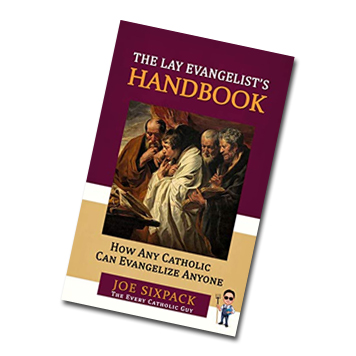Overview Of The Eight Beatitudes
By DON FIER
The dignity of the human person, as we saw last week, “is rooted in his creation in the image and likeness of God” (Catechism of the Catholic Church [CCC], n. 1700). Precisely because he is “endowed with a spiritual soul, with intellect and with free will, the human person is from his very conception ordered to God and destined for eternal beatitude” (CCC, n. 1711).
The dignity of man transcends the rest of the material universe because only he is capable of union with God — through knowledge and love — as his last end. So great is the dignity of the human person that the fathers of the Second Vatican Council were able to unequivocally affirm that he is “the only creature on earth which God willed for itself” (Gaudium et Spes [GS], n. 24 § 3).
To attain the end for which he was created, “man is obliged to follow the moral law, which urges him ‘to do what is good and avoid what is evil’ (cf. GS, n. 16). This law makes itself heard in his conscience” (CCC, n. 1713). Conscience, as defined by the Second Vatican Council, is “the most secret core and sanctuary of a man. There he is alone with God, Whose voice echoes in his depths” (GS, n. 16).
However, as we also saw last week, it is incumbent on man as a solemn duty to seek the truth and to properly form his conscience — he is responsible for what he should have and could have known. As expressed by Pope St. John Paul II, man’s conscience “compromises its dignity when it is culpably erroneous” (Veritatis Splendor [VS], n. 63 § 2).
The Catechism returns later to the topic of conscience to examine it in more depth, but at this juncture turns its attention to the Beatitudes, which are often referred to as the Magna Charta of Christian perfection. Indeed, “the Beatitudes are at the heart of Jesus’ preaching” (CCC, n. 1716) and provide a synthesis of the whole Gospel message.
Recorded as a series of eight blessings in the Gospel of St. Matthew (Matt. 5:3-12), and as four blessings and opposing woes in the Gospel of St. Luke (Luke 6:20-26), they were proclaimed by our Lord at the very beginning of His public ministry as a preamble to the Sermon on the Mount (Matt. 5-7).
“Over the centuries,” according to Fr. John A. Hardon, SJ, “Christian wisdom has speculated on how the four [St. Luke] are really eight, and how the eight [St. Matthew] can be synthesized into four” (see www.therealpresence.org and look for “Beatitudes” at the site index).
For the purpose of our consideration of the Beatitudes, St. Matthew’s account will henceforth be used.
The Beatitudes reveal in concise terms what it means to be a follower of Jesus Christ. In the first volume of his masterful two-volume work on the spiritual life entitled The Three Ages of the Interior Life (AIL), Fr. Reginald Garrigou-Lagrange, OP, states that the Beatitudes “wonderfully condense all that constitutes the ideal of Christian life and show all its loftiness” (p. 164).
Fr. Hardon describes them as providing “a portrait of the Person of Jesus Christ and His charity” (Basic Catholic Catechism Course [BCCC], p. 98). The Catechism similarly says that they “depict the countenance of Jesus Christ and portray his charity” (CCC, n. 1717).
Before proceeding any further, let us look at the etymology of the word “beatitude.” It comes from the Latin beatus, which is translated from the Greek word makarioi and means “blessed” or “happy.”
As defined by Fr. Hardon, beatitude means “happiness or blessedness as the enduring possession of perfect good. Supernatural beatitude is the perfect happiness enjoyed by a nature raised by grace and the light of glory to the eternal vision of God” (Modern Catholic Dictionary, p. 58).
Each of the eight Beatitudes begins with the word “blessed,” is followed by a condition (e.g., to be poor in spirit, to be merciful, to be a peacemaker, etc.), and then ends with the assurance of a reward for those who act in accord with the specified condition.
Pope Emeritus Benedict XVI, in the first volume of his Jesus of Nazareth trilogy, which he describes in the foreword as “solely an expression of my search ‘for the face of the Lord’ (cf. Psalm 27:8)” (p. xxiii), notes the paradoxical nature of the Beatitudes.
“The Beatitudes, spoken with the community of Jesus’ disciples in view,” writes the former Vicar of Christ, “are paradoxes — the standards of the world are turned upside down as soon as things are seen from the right perspective, which is to say, in terms of God’s values, so different from those of the world. It is precisely those who are poor in worldly terms, those thought of as lost souls, who are the truly fortunate ones, the blessed, who have every reason to rejoice and exult in the midst of their sufferings” (p. 71).
Is there a relationship between the Ten Commandments and the Beatitudes? One can see an immediate parallel in that Moses ascended Mt. Sinai to receive from God the Decalogue, and in like manner, Jesus ascended a mountain to give His followers the eight Beatitudes as a prologue to the Sermon on the Mount. However, “the Beatitudes transcend the Decalogue by calling man to imitate Christ,” teaches Fr. Hardon. “We are still called to obey God, as man was called to do on Mount Sinai, but more importantly, we are called to be transformed into His likeness” (BCCC, p. 98).
Direct confirmation of the continued relevance of the Ten Commandments is insisted upon by Christ Himself soon after He proclaims the Beatitudes:
“Think not that I have come to abolish the law and the prophets; I have come not to abolish them but to fulfill them. For truly, I say to you, till heaven and earth pass away, not an iota, not a dot, will pass from the law until all is accomplished” (Matt. 5:17-18).
In Veritatis Splendor, Pope St. John Paul II elaborates beautifully on the relationship between the Ten Commandments and the Beatitudes:
“The Beatitudes are not specifically concerned with certain particular rules of behavior. Rather, they speak of basic attitudes and dispositions in life and therefore they do not coincide exactly with the commandments. On the other hand, there is no separation or opposition between the Beatitudes and the commandments: both refer to the good, to eternal life. The Sermon on the Mount begins with the proclamation of the Beatitudes, but also refers to the commandments (cf. Matt. 5:20-48).
“At the same time, the Sermon on the Mount demonstrates the openness of the Commandments and their orientation towards the horizon of the perfection proper to the Beatitudes. These latter are above all promises, from which there also indirectly flow normative indications for the moral life. In their originality and profundity they are a sort of self-portrait of Christ, and for this very reason are invitations to discipleship and to communion of life with Christ” (VS, n. 16 § 3).
What about the ordering of the Beatitudes? In order to explain their enumeration, St. Thomas Aquinas, following the thought of St. Augustine, teaches that there are three kinds of happiness: the happiness of sensuality, of activity, and of contemplation.
He elaborates by positing that “these three kinds of happiness stand in different relations to future beatitude, by hoping for which we are said to be happy. . . . Sensual happiness, being false and contrary to reason, is an obstacle to future beatitude; while happiness of the active life is a disposition of future beatitude; and contemplative happiness, if perfect, is the very essence of future beatitude, and, if imperfect, is a beginning thereof” (Summa Theologiae I-II, Q. 69, art. 3).
True Happiness
Fr. Garrigou-Lagrange admirably summarizes how St. Thomas divides the eight Beatitudes into three groups that correspond to the three types of happiness.
“The first three beatitudes [Matt. 5:3-5] tell of the happiness that is found in the flight from sin and deliverance from it: in poverty accepted for love of God, in meekness, and in the tears of contrition” (AIL, p. 165).
These first three Beatitudes promise a reward to those who are willing to moderate or even forgo sensual pleasures, even legitimate “things,” out of love for God and neighbor.
The next two Beatitudes (Matt. 5:6-7) are those of the active life and “correspond to the thirst for justice and to mercy exercised toward one’s neighbor” (AIL, p. 165). Freed from evil, the Christian who is engaged in the active apostolate devotes himself to the pursuit of good with all the ardor and zeal of his heart.
The next two Beatitudes correspond to “the contemplation of the mysteries of God [Matt. 5:8-9]: the purity of heart which prepares the soul to see God, and the peace that springs from true wisdom” (ibid.).
The eighth and most perfect Beatitude (Matt. 5:10-11), then, unites the preceding seven “in the very midst of persecution endured for justice’ sake. These are the final trials, the conditions of sanctity” (ibid.).
“The Beatitudes respond to the natural desire for happiness . . . [that] God has placed in the human heart in order to draw man to the One who alone can fulfill it” (CCC, n. 1718).
True happiness, or beatitude, is God’s promise to those who live the Beatitudes, an undertaking which is possible only with the help of God’s grace. Over the next few weeks, we will examine each of the Beatitudes and attempt to show how God’s grace can make them a reality in our lives.
+ + +
(Don Fier serves on the board of directors for The Catholic Servant, a Minneapolis-based monthly publication. He and his wife are the parents of seven children. Fier is a 2009 graduate of Ave Maria University’s Institute for Pastoral Theology. He is a Consecrated Marian Catechist.)









